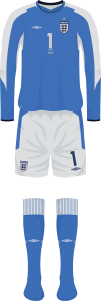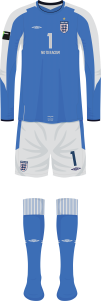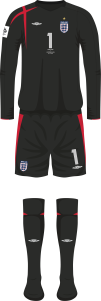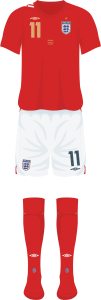Usually with national teams, I either document them for a kit cycle or from the qualification stages of a tournament until its finals if they reach that, or perhaps both as those criteria can overlap. That can be simple enough but if the kits’ release dates are staggered during that period, it can throw a spanner into the works but here I go.
Following on from their Euro 2004 quarter-final defeat to hosts Portugal on a penalty shootout, England’s home kits under Umbro were typically unveiled every odd year and the away even. This lets one of the active strips to be in use at a major tournament, providing they qualify.


Another quirk of this practice allows both to be of different styles, not using the same template as each other. In this instance, the home was released in 2003 and the away in the run-up to the European Championship.
The Three Lions landed back to Earth with a friendly against Ukraine just four days into the new Premier League season, a peculiar international break that has since been removed from FIFA’s calender.
Despite being at home, this instance playing at St James’ Park whilst Wembley was being rebuilt, they opted for their change uniform. This has been a common trend for the team that was toned down later in the decade but picked up again in the early 2020s.
In red, it featured the St George’s Cross on the shoulders through white outlines and off-white shiny shorts. It utilised Umbro’s X-Static technology, embedding strips of silver into the fabric to mitigate the growth of odorous microorganisms.

The visitors choosing blue meant that David James went for the yellow-and-navy blue goalkeeping wears from 2002, albeit with the updated home font. The black-and-red outfit last seen versus France at the Euros would not be used again.
Qualification for the 2006 World Cup in Germany started three weeks later and up first was away to Austria.
In their home strip’s first outing since the summer tournament, it was the first to feature a star to denote the World Cup win of 1966. Due to the badge being placed directly below the placket, it was positioned on the left sleeve.
The away kit’s conventional appliqué placement allowed it’s to be above the crest so with everything placed so close together in the middle of the primary shirt, the match details were printed just above the hem to reduce the clutter on that one.

James went for his blue-and-silver getup that was launched along with the change, where the match details were directly below the chest number like its red outfield counterpart.
Poland away was four days later and their white kit meant England had to change. As with the visitor’s first game, neither side wore the qualification sleeve patches, along with several other nations for some reason.
The next two matchdays were a month later, against neighbours Wales at Old Trafford and then at Azerbaijan. White and red were respectively worn now with the aforementioned patches, although they were missing off the long-sleeved outfielders in the latter tie.

A trip to Madrid in November to play Spain concluded the calender year. It was the swansong for the home kit, paired with white alternate shorts for the occasion.

Yellow-and-navy was picked for Robinson, now with plain socks meaning it was now the de facto second-choice for the shot stoppers, behind the blue.
Friendly in name only, a hot-tempered affair on the pitch was compounded by monkey chants from the stands aimed at England’s black players. This came a month after Spanish coach Luis Aragonés made racist remarks against Thierry Henry, to supposedly motivate his club teammate José Antonio Reyes in training.
Come the new year, the next fixture saw the Netherlands be entertained at Villa Park. In light of the previous time out and the events prior, Nike through its athlete Henry launched the Stand Up Speak Up initiative and through that, gave its European national teams special black-and-white halved jerseys for this round of games.


The hosts followed suit by having ‘no to racism’ printed below the chest number and having the logo of Let’s Kick Racism Out of Football on the right sleeve. Because of the one-off Dutch shirts, England wore red at home again.
The torso markings meant that the match details had to be moved to the hem, the first time on this top and the last time by the men’s senior side at least.
Qualification resumed at the end of March but not long before that, the new home kit was unveiled.

A collar returned after six years but the main draw was the red cross on the right shoulder, making two strips nodding to the flag, despite the change not being used again by the men’s after the Netherlands.

Its typeface had a slight cosmetic update, now having a silver outline instead of white and had the badge at the base of the back numbers.
The short numbers were identical to the away set, silver with a white keyline, replacing the old ones that were white with a navy border.
It made its debut against Northern Ireland and was used again a few days later versus Azerbaijan.

The goalkeepers got a navy strip with a few minor differences from its outfield counterpart and for some reason, there was a desaturated version.

Seemingly superfluous, the off-black uniform was first used against the Azeris, whose away shirt was a standard shade of blue that didn’t render the navy one unsuitable.
Come the end of the domestic season, England travelled to the United States for a two-game tour at the end of May.
The standard home kit was used against the hosts, who themselves went navy with white shorts. With the first-choice goalkeeping uniform clashing, the slate outfit in its second consecutive run-out didn’t do much to stand out.

Colombia were the other opponents and against them, all-white was the order the day.
For the next five games; a friendly in Denmark at the start of 2005-06 and the last sets of qualifiers, the standard home strips were used as they topped their group and progressed to the finals.
The year ended again with a prestige friendly, this time against Argentina on neutral territory in Switzerland, aptly enough. Winning the toss, England chose their home colours so la Albiceleste had to deviate from their traditional stripes and go dark blue instead.

Of course, this brought out that problem which was ignored against the USA back in spring. The solution was to dig out the yellow goalkeeper jersey from 2002 for the fourth and final time. Incidentally, each of its outings had a different variant to it, this time donning the 2005 print.
The first half of the new year was focusing on preparation for the upcoming World Cup. Up next was Uruguay in March but before that, there was the small matter of the launch of the latest change kit.

Not too dissimilar from the previous offerings, it was red with white shorts and featured a more standard Cross, this time subdued along the right shoulder. The higher placement of Umbro’s double diamond logo above the right breast allowed the front number to be placed beneath it.

A white-bordered gold typeset with perforated numbers were used on the shirts, matching the stitching on the back. Navy with gold outline for the shorts, the larger rear digits retained the crest.
Premiering in said Uruguay match, substitute and debutant Peter Crouch infamously had his numbers switched around on his back, showing 12 whilst he was registered as number 21.

The new goalkeeping attire followed the same design cues but with extra flashes on the upper sleeves and different construction on the sides of the shorts. Predominantly in a darker shade of blue, the panelling and socks were navy.
With less than a fortnight away to the tournament, two more friendlies at Old Trafford were lined up. Up first were Hungary, where the home kit was chosen in the only instance it was picked for a home friendly.
Incidentally, Paul Robinson’s had his chest number placed centrally to match his teammates, the only time that happened with this top and all.
Red got the nod versus Jamaica in the final game before heading to Germany, where Jimmy Cliff stole the show before a ball was kicked.


As one of the top seeds in the draw, they were paired with Paraguay, Sweden and debutants Trinidad and Tobago in Group B.
The South Americans were the first opponents on day 2 of the finals and with England assigned as the home team, they had priority in the kit stakes and averted the phenomena where both teams would possibly have to change.
Naturally wearing red-and-white stripes, los Guaraníes were made to change, going with their blue back-up.

This meant that Robinson had to go with something different; a new all-yellow ensemble.
Trinidad and Tobago didn’t cause any problems on the aesthetics front but they had to go all-red instead of using their default black shorts as the Three Lions were designated the home side again.
Sweden were up last, drawing each other in the group stage for the second time in succession. Being the administrative home team for this, the respective light colours of each nation meant that England had to don red.

This caused a slight pickle between the sticks as Blågult‘s self-explanatory nickname (meaning ‘blue and yellow’, for the non-Swedish speakers) clashed with the custodian’s kits. To remedy this, the slate one finally served a purpose, now with gold printing.
Winning the group, they drew with Group A runners-up Ecuador in the Round of 16 but bizarrely, the problems that arose with Sweden weren’t regarded here. Both wore their light shirts and where la Tri also had one blue sleeve, England went on to wear that colour in net.
Portugal were faced in the next round and both went with their first-choice options. As it was two years prior, a quarter-final penalty shootout loss to the Iberians was the end of the road.
The home kit stayed on after the tournament up until the end of the year, starting off the ill-fated Euro 2008 qualifiers, eventually getting replaced in early 2007.